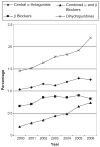Patterns of outpatient antihypertensive medication use during pregnancy in a Medicaid population
- PMID: 22966012
- PMCID: PMC3501756
- DOI: 10.1161/HYPERTENSIONAHA.112.197095
Patterns of outpatient antihypertensive medication use during pregnancy in a Medicaid population
Abstract
Hypertensive disorders occur in approximately 6% to 8% of all pregnancies and are a significant source of maternal and fetal morbidity. Little is known about the range of agents routinely used in practice. We used Medicaid claims from 2000 to 2007 to identify completed pregnancies. We included women who were Medicaid beneficiaries from at least 3 months prior to last menstrual period to 1 month postdelivery, and were successfully linked to infant records. Maternal exposure to antihypertensive medications was derived from Medicaid pharmacy claim files, and duration of exposure was assigned based on the days' supply dispensed. We identified 1,106,757 Medicaid patients in our cohort, of whom 48,453 (4.4%) were exposed to antihypertensive medications during pregnancy. The prevalence of antihypertensive use increased from 3.5% to 4.9% during the study period. Antihypertensive medication users were older than nonusers, more likely to be white or black, and more likely to have comorbid diabetes mellitus and renal disease. Overall, 1.9% of pregnant women were exposed during the first trimester, 1.7% during the second trimester, and 3.2% during the third trimester. The range of antihypertensive medications to which patients were exposed was highly heterogeneous and frequently included agents other than methyldopa or labetalol. Angiotensin-converting enzyme inhibitor exposure, which is contraindicated in late pregnancy, occurred in 928 (4.9%) antihypertensive medication users in the second trimester and 383 (1.1%) in the third trimester. Antihypertensive use during pregnancy is relatively common and increasing. The wide range of agents used during pregnancy includes medications considered contraindicated during pregnancy.
Conflict of interest statement
Figures



Similar articles
-
Impact of two Medicaid prior-authorization policies on antihypertensive use and costs among Michigan and Indiana residents dually enrolled in Medicaid and Medicare: results of a longitudinal, population-based study.Clin Ther. 2010 Apr;32(4):729-41; discussion 716. doi: 10.1016/j.clinthera.2010.04.007. Clin Ther. 2010. PMID: 20435243 Free PMC article.
-
Patterns of antihypertensive use among patients in the US Department of Defense database initially prescribed an angiotensin-converting enzyme inhibitor or calcium channel blocker.Clin Ther. 1997 Nov-Dec;19(6):1433-45; discussion 1424-5. doi: 10.1016/s0149-2918(97)80017-3. Clin Ther. 1997. PMID: 9444451
-
Prescription of antihypertensive medications during pregnancy in the UK.Pharmacoepidemiol Drug Saf. 2014 Oct;23(10):1051-8. doi: 10.1002/pds.3641. Epub 2014 May 2. Pharmacoepidemiol Drug Saf. 2014. PMID: 24797728 Free PMC article.
-
In Utero Exposure to Antihypertensive Medication during the First Trimester: Is the Risk Worth Taking?Acta Med Acad. 2021 Dec;50(3):372-381. doi: 10.5644/ama2006-124.356. Acta Med Acad. 2021. PMID: 35164513 Review.
-
Antihypertensive drugs in pregnancy.Semin Nephrol. 2011 Jan;31(1):70-85. doi: 10.1016/j.semnephrol.2010.10.007. Semin Nephrol. 2011. PMID: 21266266 Review.
Cited by
-
β-Blocker Use in Pregnancy and the Risk for Congenital Malformations: An International Cohort Study.Ann Intern Med. 2018 Nov 20;169(10):665-673. doi: 10.7326/M18-0338. Epub 2018 Oct 16. Ann Intern Med. 2018. PMID: 30326014 Free PMC article.
-
Surveillance of Medication Use During Pregnancy in the Mini-Sentinel Program.Matern Child Health J. 2016 Apr;20(4):895-903. doi: 10.1007/s10995-015-1878-8. Matern Child Health J. 2016. PMID: 26645616
-
The Impact of Pregnancy on Antihypertensive Drug Metabolism and Pharmacokinetics: Current Status and Future Directions.Expert Opin Drug Metab Toxicol. 2021 Nov;17(11):1261-1279. doi: 10.1080/17425255.2021.2002845. Expert Opin Drug Metab Toxicol. 2021. PMID: 34739303 Free PMC article. Review.
-
Outpatient calcium-channel blockers and the risk of postpartum haemorrhage: a cohort study.BJOG. 2013 Dec;120(13):1668-76; dicussion 1676-7. doi: 10.1111/1471-0528.12428. Epub 2013 Sep 11. BJOG. 2013. PMID: 24020971 Free PMC article.
-
Drug treatment of hypertension in pregnancy.Drugs. 2014 Mar;74(3):283-96. doi: 10.1007/s40265-014-0187-7. Drugs. 2014. PMID: 24554373 Free PMC article. Review.
References
-
- Brown MA, Lindheimer MD, de Swiet M, Van Assche A, Moutquin JM. The classification and diagnosis of the hypertensive disorders of pregnancy: Statement from the international society for the study of hypertension in pregnancy (ISSHP) Hypertens Pregnancy. 2001;20:IX–XIV. - PubMed
-
- Kuklina EV, Ayala C, Callaghan WM. Hypertensive disorders and severe obstetric morbidity in the united states. Obstet Gynecol. 2009;113:1299–1306. - PubMed
-
- Report of the national high blood pressure education program working group on high blood pressure in pregnancy. Am J Obstet Gynecol. 2000;183:S1–S22. - PubMed
-
- Acog practice bulletin. Diagnosis and management of preeclampsia and eclampsia. Number 33, january 2002. Obstet Gynecol. 2002;99:159–167. - PubMed
-
- Acog practice bulletin. Chronic hypertension in pregnancy. Acog committee on practice bulletins. Obstet Gynecol. 2001;98(suppl):177–185. - PubMed
Publication types
MeSH terms
Substances
Grants and funding
LinkOut - more resources
Full Text Sources
Medical

